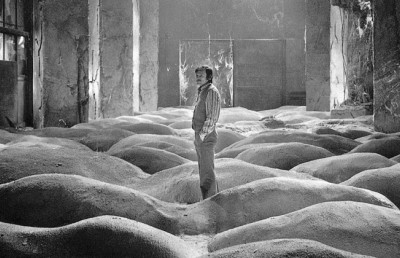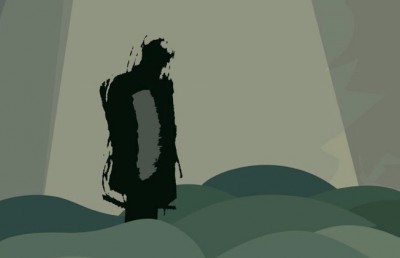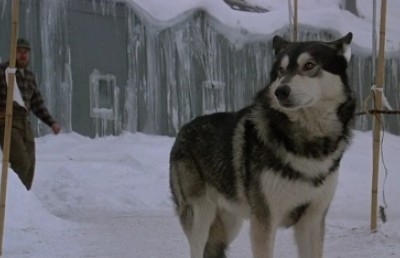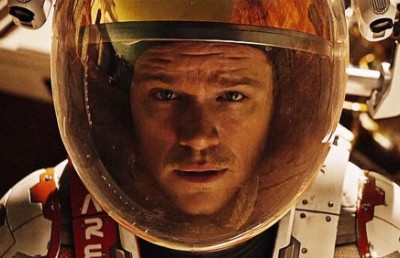The Startle as Art: Part 2 of a Study of the Use of the Startle Effect in The Thing
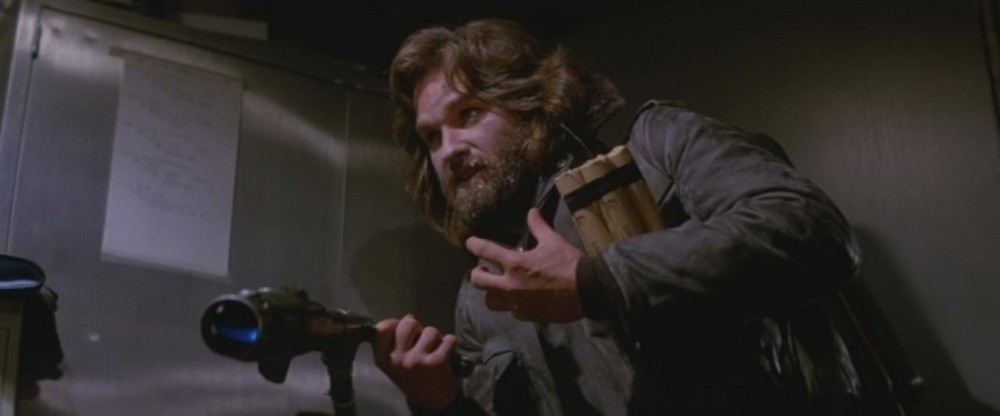
In the first part of my essay, “Engineering Shock: Part 1 of a Study of the Use of the Startle Effect in The Thing,” I analysed two distinct examples of horror film startles from John Carpenter’s film The Thing (1982). The purpose was to explain the use of startles in horror films by contrasting a basic example with a more intricately crafted one. I also tried to show how, far from the accusation that they are merely cheap effects, startles are actually capable of being constructed in an interesting way. Taking that argument further, for this essay I am going to look at the film’s “blood testing” scene, as I believe it contains the most formally complex startle in the film. 1 I not only consider this to be perhaps my favorite startle of all time, but, more generally, I see this whole sequence as brilliantly crafted cinema. Consequently, in this part I will perform an exhaustive study of this scene, providing another shot-by-shot breakdown, followed by a lengthy analysis of the various formal strategies it employs. What I seek to demonstrate are the many ways in which the film creates and controls its atmosphere, while simultaneously misdirecting the audience’s attention through subtle yet meticulous means. On a more fundamental level, I wish to show why I believe certain startles can merit serious prolonged attention.
Example #3 – The Blood TestThe Plot
The crew has dealt with Norris-Thing, but tensions have mounted. Clark, having kept the scalpel, eventually tries to rush MacReady. Seeing him in the corner of his eye, MacReady, now in possession of a revolver, quickly turns and shoots Clark in the head. Having lost several men in a short time, the characters are now hyper-paranoid and suspicious of each other.
Shots 1-6: Explaining the Test
(1) The scene starts with a close-up shot of Clark lying dead on the rec room’s pool table with a bullet hole in his forehead. Half of his face is masked in an ominous blue light that suggests he might have been infected. 2 The camera pulls back to show the body of Copper next to him, as Palmer ties rope around the two corpses. Palmer turns to MacReady (off camera), complaining that it’s insane to tie up corpses. In light of the incident with Norris, we understand MacReady when he orders Palmer to “finish it.”
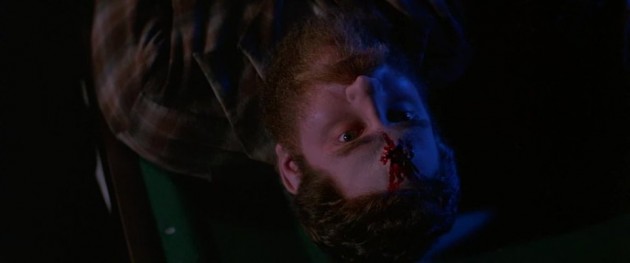

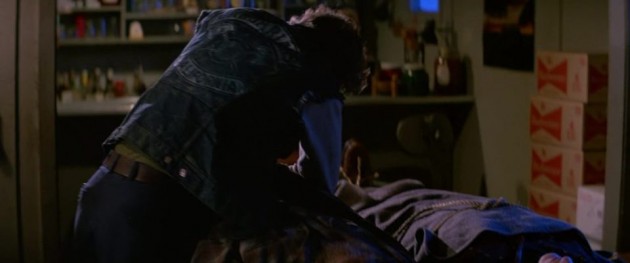
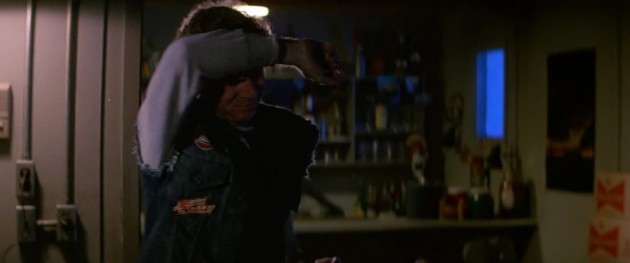
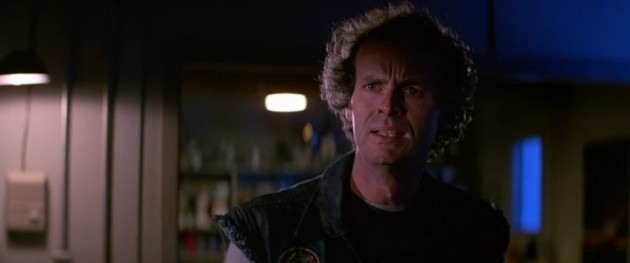
(2) We cut to an extreme close-up of MacReady’s hands filing down a bit of metal wire that he plans to use in a test he has devised. (3) Cut back to medium-long shot of MacReady continuing this action. Despite the wideness of the frame, MacReady is the only one in the shot. On the wall to the right side of the frame we can see an old war poster warning about the dangers of VD. It has a picture of a woman and the words “They Aren’t Labelled, Chum” written across the top. This poster and its appropriately foreboding message can be clearly seen throughout this sequence. The shot ends when MacReady tells Windows to tie Palmer to the couch.

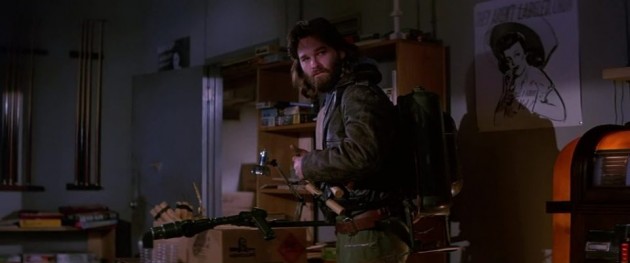
(4) We then jump ahead in time to a close-up of Windows. He is sitting in front of Palmer, who has been tied up. MacReady begins talking and, as he explains his plan, the camera slowly moves in a right-to-left motion across the other characters faces, stopping briefly to stress each close-up. There is quite a bit to discuss about this movement. At its most basic level, it reminds us who is still alive. Looking deeper, the movement goes against the more popular use of left-to-right movements employed in most films. As film historian Drew Caspar notes when discussing the right-to-left tracking shot early in 12 Angry Men, because many languages (and consequently images) are read in a left-to-right manner, it is often felt that shots moving counter to this feel slightly unnatural in some way. 3 In terms of The Thing, the movement can be seen as another subtle means of enhancing the uneasy atmosphere. It is made more uneasy by the placement of the actors. Early in the shot we see three characters, Windows, Palmer, and Garry, all occupying part of the frame. As the movement plays out, the distances between the characters get progressively larger until, in between Childs and Nauls, we get a brief moment where the frame is almost entirely uninhabited. Through a simple movement, Carpenter creates a sense of tension while subtly conveying the growing psychological separation between the remaining characters. This movement may seem trivial; honestly, how many would even consciously notice it? Yet, as I will argue, part of what drives this scene is a meticulous attention to form which is coupled with an urge to have this meticulousness go almost entirely unnoticed by the viewer.

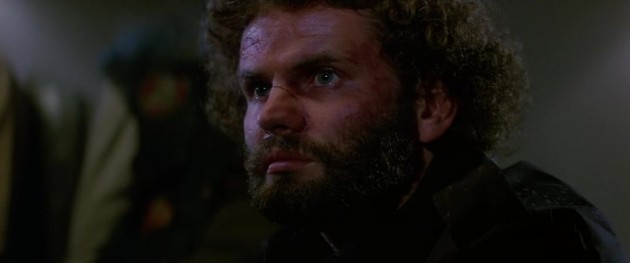
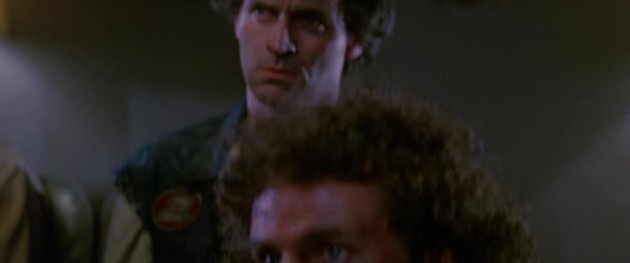

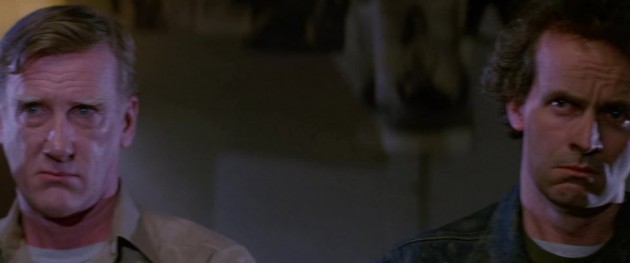
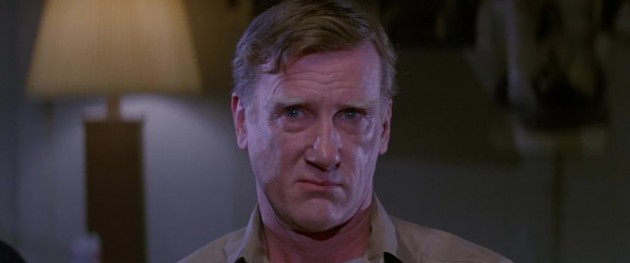
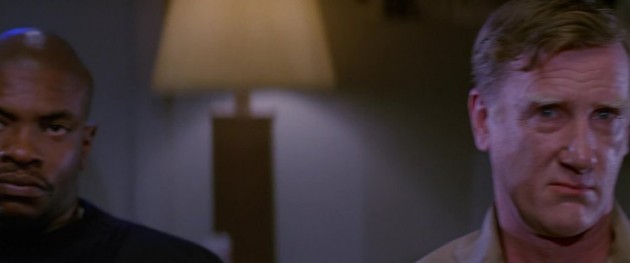
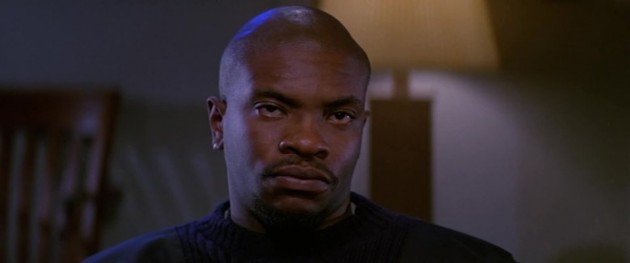
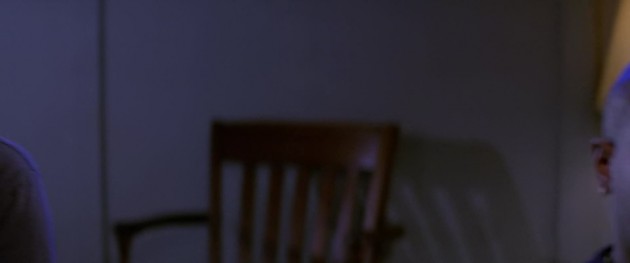
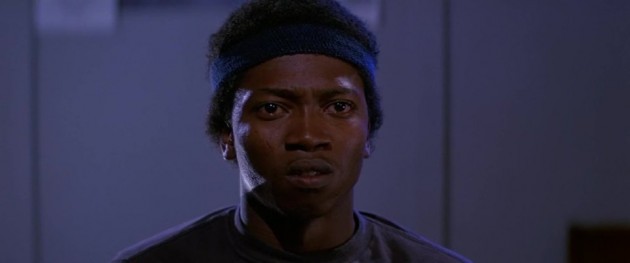
(5) After the tracking shot, we cut to a medium close-up of MacReady. Like the earlier shot, this one also moves as he talks. Unlike the other one, this shot slowly tracks forward. It continues until MacReady is framed in an intense close-up. In both this shot and the last MacReady explains how he plans to find out who is the Thing. All of the characters are to provide blood samples which MacReady will prod with a scolding metal wire. MacReady figures that each cell of the Thing is a living entity, and, because of this, any alien blood will try to protect itself when attacked. What is of interest here is that Carpenter essentially has MacReady tell us that we are going to be startled. It is unclear what reaction the blood will have, but we expect something shocking to happen.
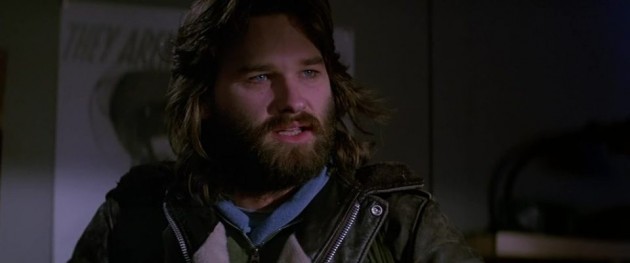
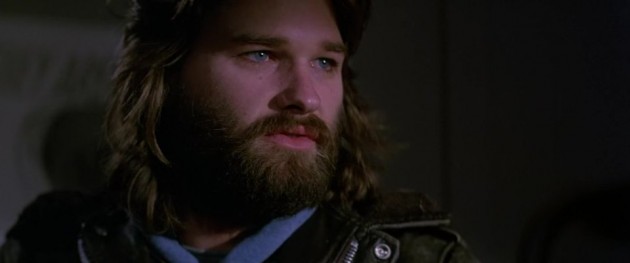
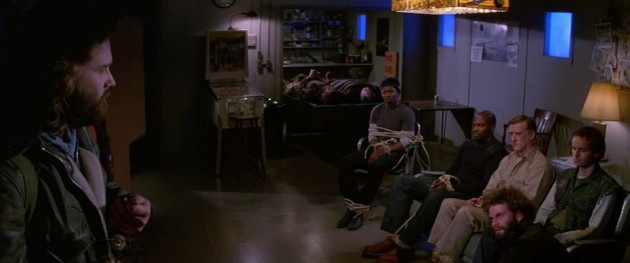
(6) We finally cut to what could be considered an establishing shot, as it is widely framed and clearly shows the spatial relationship between the characters. Occupying the far left of the frame, MacReady is yet again separated from the rest of the crew, who are shown tied up on the right side of the frame. Far off in the background we can even see the pool table with the bodies of Clark and Copper on top. This is, incidentally, one of only two instances in this sequence of 57 shots that present all of the characters in the frame at once. 4
Shots 7-16: Collecting the Blood(7) We jump ahead in time again as we see a close-up of Windows’ and Nauls’ hands. Windows right hand cuts Nauls’ thumb with a scalpel while his left hand holds a Petri dish under the wound. (8) On the incision we see a close-up reaction shot as Nauls gasps slightly at the sting of the blade. (9) We then cut to a reverse shot of Windows, who appears uncomfortable doing this, (10) before cutting back to the earlier close-up of the hands. We see that Nauls’ blood has been collected in the small dish.
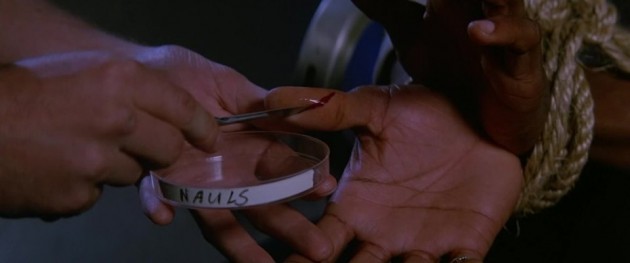
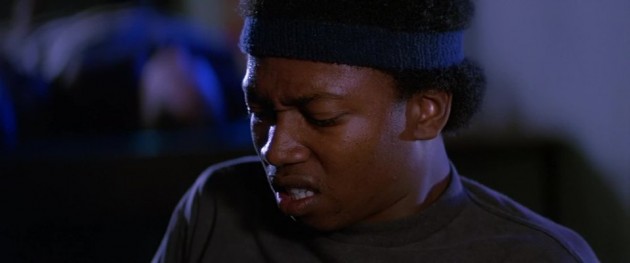
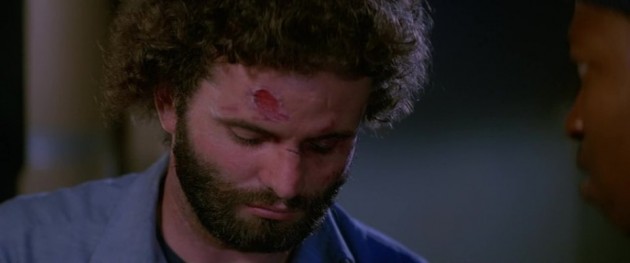
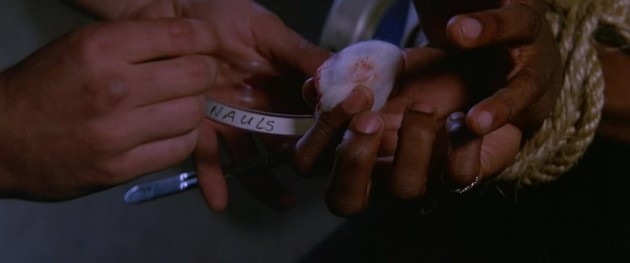
(11) In a longer shot we see Windows hand the Petri dish to MacReady. Before testing can commence however, Windows is told to collect some of his own blood. (12) We cut to a close-up of Windows’ hands and see him cut the back of his thumb with the scalpel. In an unsettling moment, the blood slowly squirts into a Petri dish with Windows’ name written on it. Both this shot and the one of Nauls increase the feeling of uneasiness by adding slight moments designed to make audiences cringe. The shot of Windows in particular is disturbing as we don’t see the gash. We only hear the sound, see the blood squirt, while the wound itself is left to our imaginations. Carpenter has noted that, in his experiences viewing the film in theaters, this shot never fails to make audiences visibly squirm (Carpenter and Russell). On a more important level, these shots also establish and emphasize the visual motif of the blood in a Petri dish; a motif which Carpenter will manipulate to great effect later in the sequence.
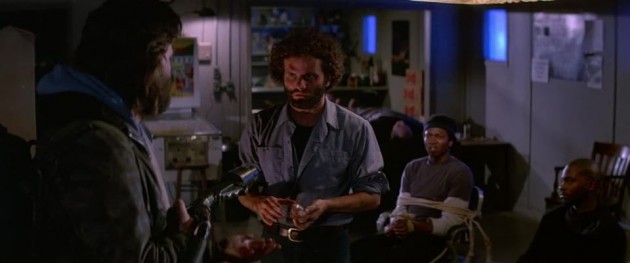
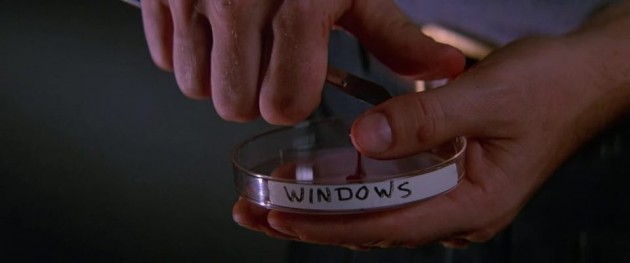
(13) Having collected enough blood, Windows gives MacReady the dish in a medium-close-up and, (14) as we cut to a close-up of MacReady, Windows is told to move to the other side of the room. (15) In the same framing as shot 11, Windows moves to the right. (16) We see Windows continue this action at the start of this medium shot of MacReady. After Windows moves off-screen, MacReady grabs the spool of metal wire and holds the exposed tip in front of his flamethrower’s pilot light.
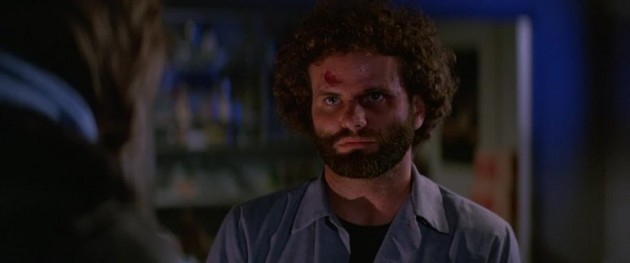
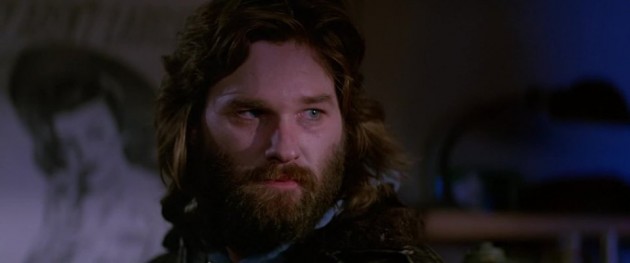
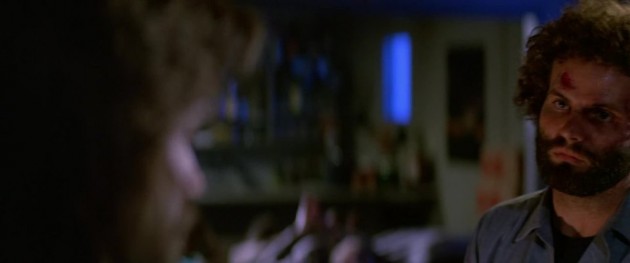
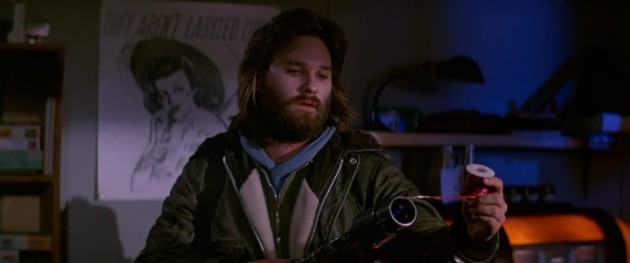
(17) An extreme close-up of the wire being heated in front of the flamethrower. (18) Return to Windows as he slowly backs away from the camera, stopping when he is framed in a medium shot. He lowers his head slightly, causing the lighting to form sinister shadows on his face.
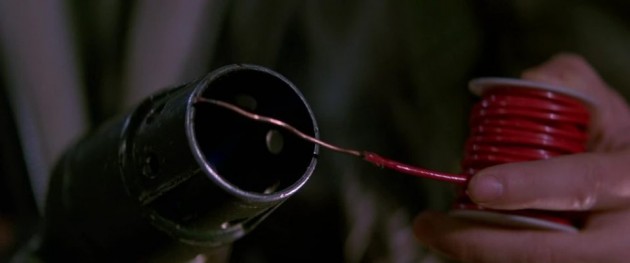
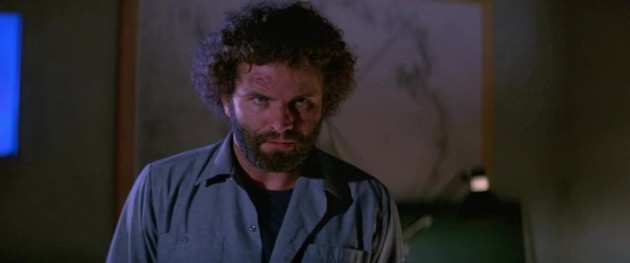
(19) After cutting back to the close-up of the wire in front of the flamethrower, Carpenter offers several interconnected, Kuleshov-like shots. (20) First, we get a close-up of Palmer and realize, in retrospect, that the earlier shot (18) was actually a point of view shot. Palmer’s gaze shifts and (21) we eyeline match to a close-up of the Petri dish with Windows’ name on it. (22) We then cut to Garry, and notice that his eyes are also oscillating between the blood and the wire. As in Kuleshov’s experiments, their faces convey little emotion, but by presenting these collective POV shots, Carpenter gives us an idea of what the characters are thinking; specifically, he gives us a sense that they think the test might actually work.
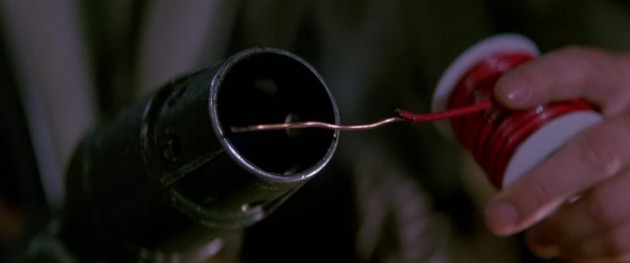
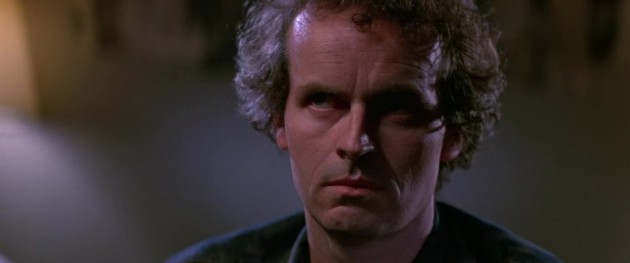
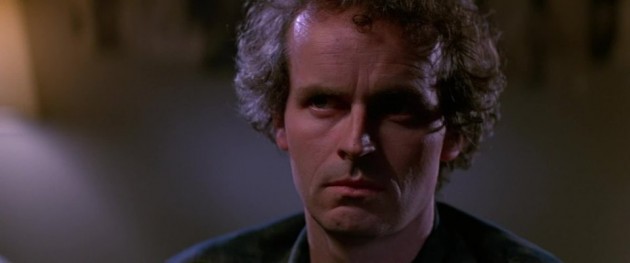


Shots 23-30: Windows
(23) A close-up of MacReady. He is nearly done heating the wire. (24) Cut to Windows looking nervously in MacReady’s direction, (25) followed by another apparent POV close-up of the wire being heated. The wire finally moves away from the flamethrower. (26) Yet another close-up of MacReady. He turns to the blood and (27) we eyeline match to a close-up of the Petri dish on the table. The wire comes within centimetres of touching the blood when (28) we cut to a brief shot of Windows holding his breath as he anxiously watches to see if he is infected. (29) We cut back to the blood, the wire makes contact and – it simply burns, nothing more. (30) Windows exhales in relief.
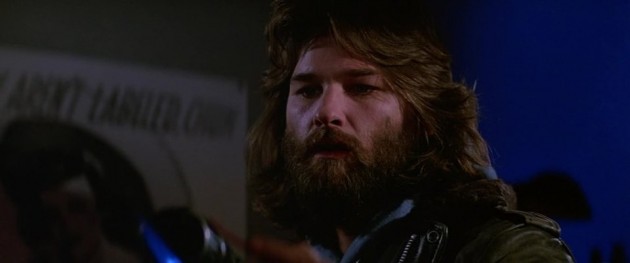
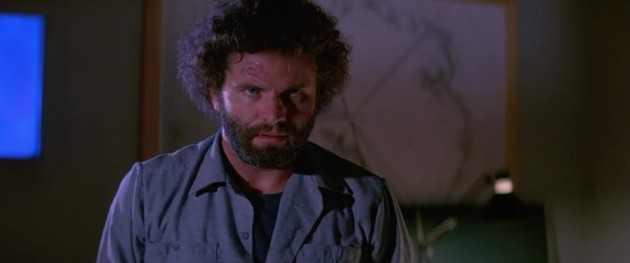
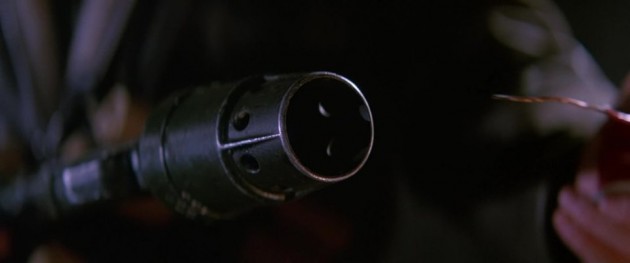
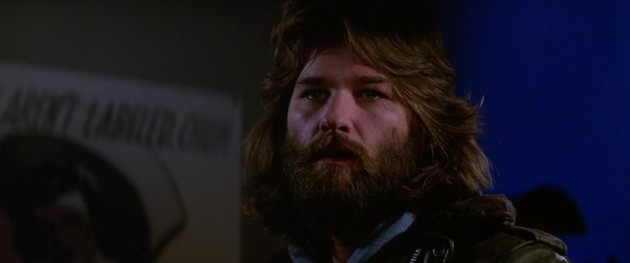
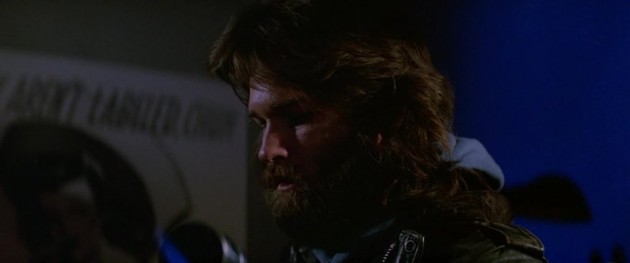
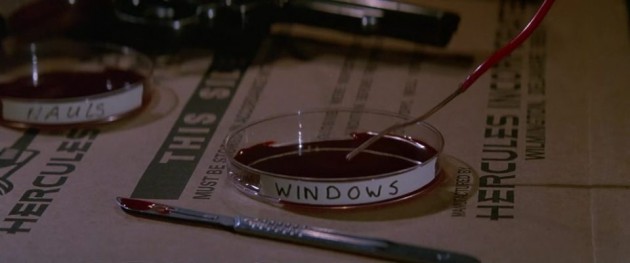
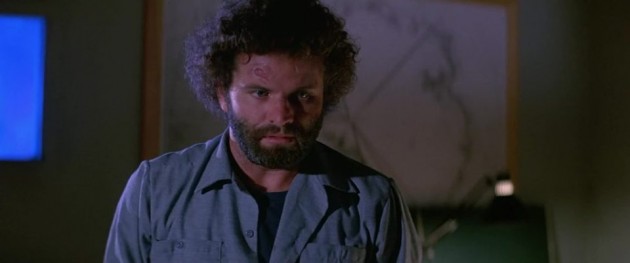

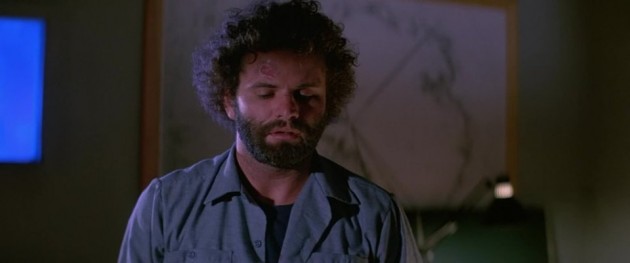
I would like to draw attention to two things during this sequence. First, Carpenter distorts time for a brief instant. The shot of Windows holding his breath (28) is contradictory on a temporal level, even though it passes so quickly that we do not realize it when watching the film. Given the closeness of the wire at the end of shot 27, we should get the result in the next shot, rather than delaying it to 29. It is a simple move, yet Carpenter has time to halt for the brief instant when we see Windows’ nervous reaction. This can be viewed as a means of drawing out the suspense, but also as a means of giving us Windows’ subjective view of time in that moment. Which leads to the second thing I would like to mention: Windows effectively represents us (the audience) in this sequence. When he holds his breath, as if waiting for something to happen, we are doing the same. Likewise, when he exhales in relief; we are also briefly relieved nothing startled us. Ultimately, the moment can be seen as a kind of emotional catharsis, effectively releasing a good deal of the tension we may have felt.
Shots 31-37: MacReady
(31) The suspense momentarily over, we cut to a medium shot of MacReady. He tells Windows to grab the other flamethrower and keep an eye on the others. (32) In a reverse shot, Windows collects himself and walks off camera towards the flamethrower. (33) Briefly we go to a close-up of Childs as his eyes follow Windows; he looks sceptical.
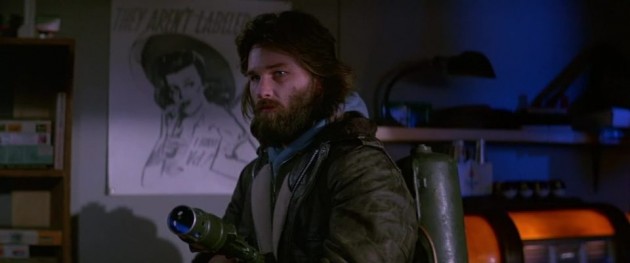
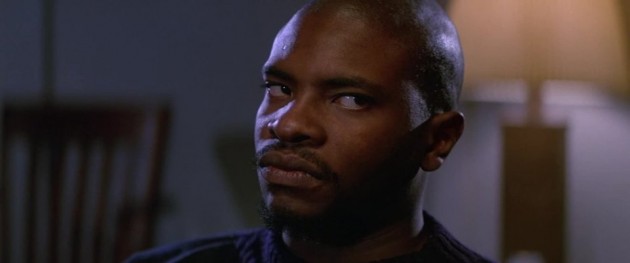
(34) Another close shot of the wire being heated in front of the flamethrower. (35) MacReady announces in a close-up that he will now test his own blood. His arm moves downward and (36) we cut to a close-up of the wire touching the blood. Once again, nothing happens. The short montage sequence before the test is also markedly less intense in both shot length and the number of cuts used.
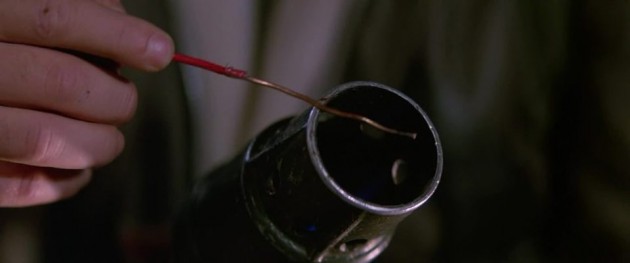
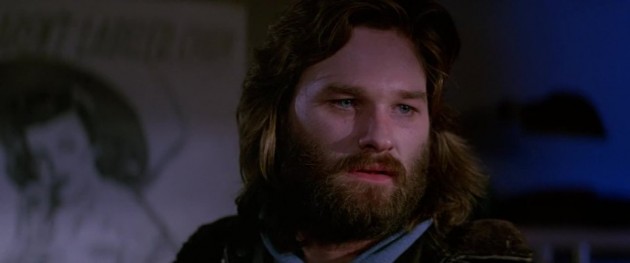
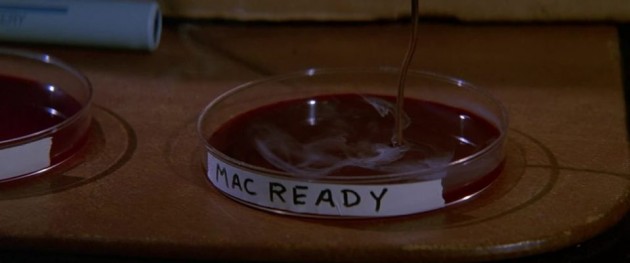
(37) Another close-up of Childs. He openly expresses his skepticism, calling the test a “crock-a-shit.” At this point Carpenter actively begins his misdirection. Characters are starting to doubt MacReady. Moreover, the editing is slowly shifting its focus away from the test, redirecting it to the drama occurring between the characters.
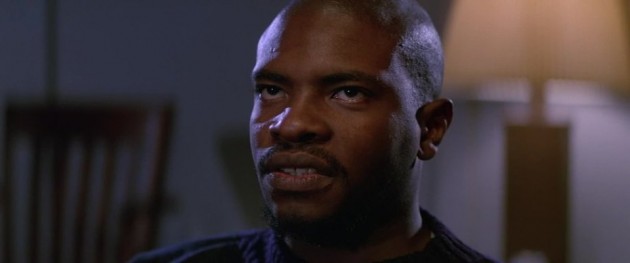
Shots 38-47: ‘The Doc’ & Clark
(38) Like the shot of MacReady following the first test, we get another medium shot as he reheats of the wire. He states that he will now test blood from the bodies of Copper and Clark. (39) Nauls, in a close-up, looks over his shoulder. The camera pans and racks focus until we clearly see the two bodies behind him in the background.
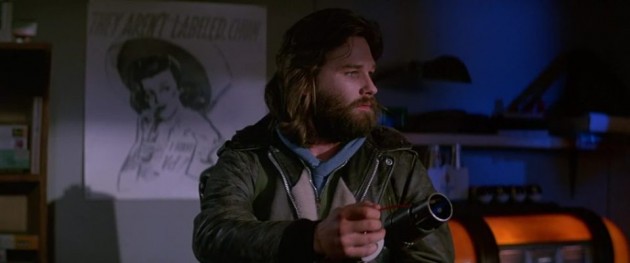
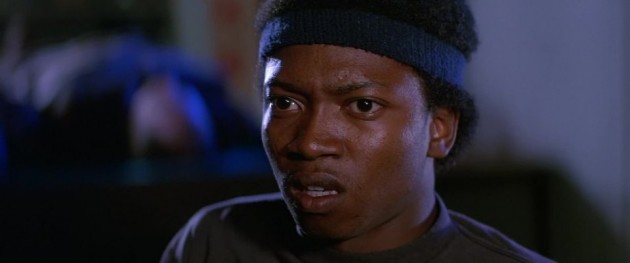
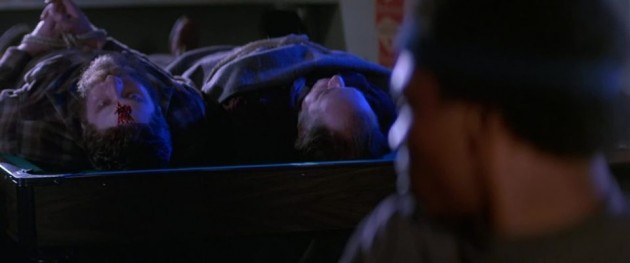
(40) We cut to close-up of blood in a Petri dish with “Copper” written on it. MacReady’s hand enters and lifts it up out of the frame. (41) A close-up of MacReady, (42) followed by a close-up of the wire touching the blood – nothing. In these shots, MacReady establishes the habit of picking up the blood before testing. It may reveal slight desperation on his part, but it also makes the audience less likely to believe that the blood will do anything. After all, how can Carpenter have Rob Bottin rig an effect under the blood if Kurt Russell is visibly holding the dish?
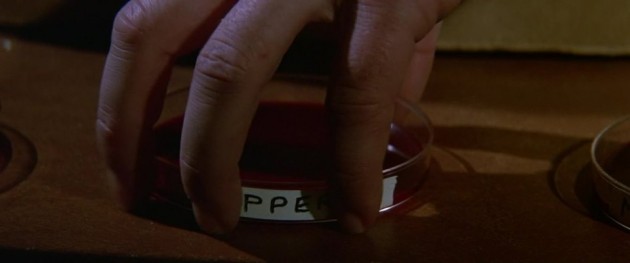
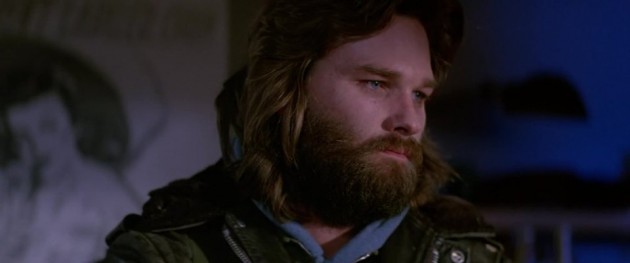
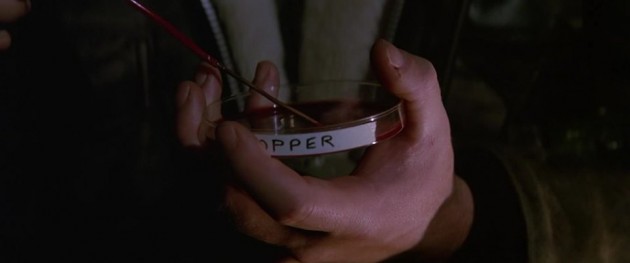
(43) Back to a medium shot of MacReady as he heats the wire and grabs Clark’s dish. (44) Cut to a medium close-up of Windows holding the other flamethrower on the crew. (45) A reverse version of the earlier shot with Nauls. The camera pans and racks focus from the bodies back to his face as he turns to MacReady to see if Clark was actually infected. (46) A low-angle medium close-up of MacReady holding the dish. We don’t see the blood itself. He puts the wire in — nothing.
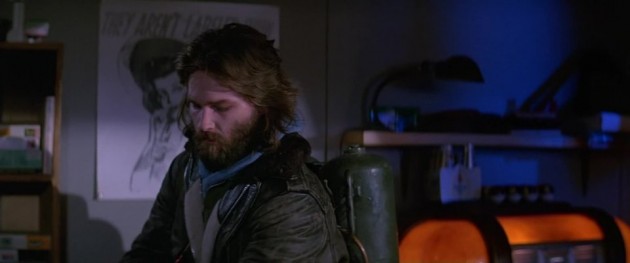
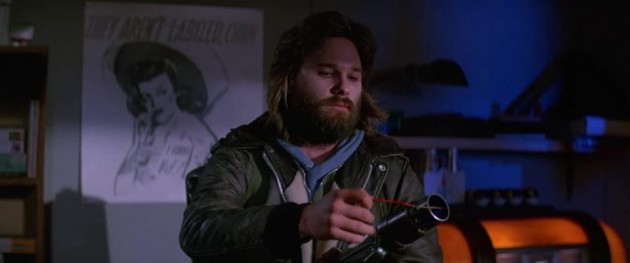
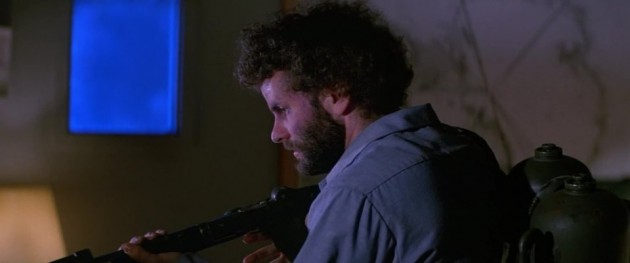
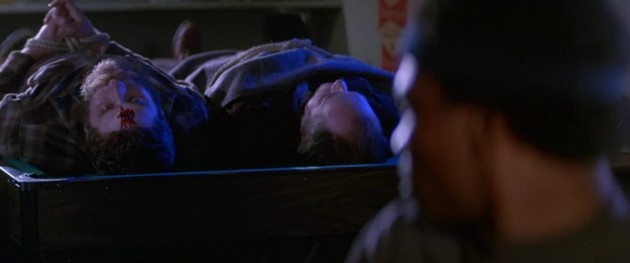
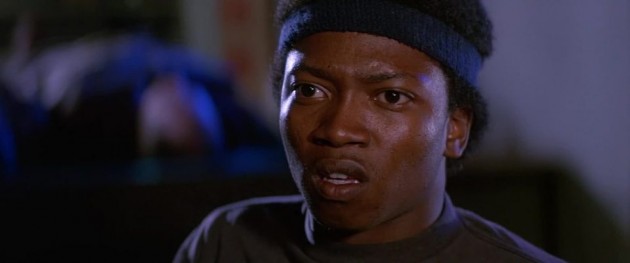
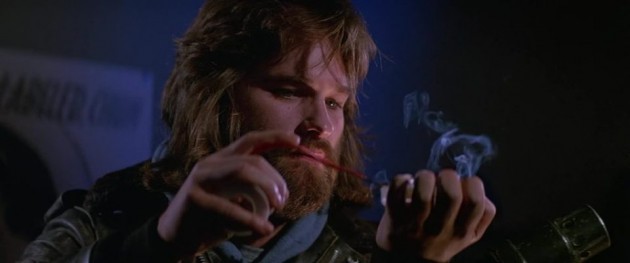
“No one really believes [MacReady] at this point,” notes Carpenter in the film’s commentary (Carpenter and Russell). Indeed, Clark had been considered one of the characters most likely to be infected. 5 The editing also furthers our own skepticism in a clever way as there are few cuts in the sequence building to this test. In fact, the number of shots between each test dwindles as the testing becomes routine. Between the first and second test there were six shots; between the second and third there were five; and from the third to this test, three. We also no longer get intense close-ups of the blood or the metal wire being heated by the flamethrower. When I say that this film doesn’t want to have its meticulousness noticed by the audience, this is one of the ways it goes about it. Rather than adding new elements to blatantly distract us, Carpenter and the film’s editor Todd Ramsay gradually remove old ones. 6 After all, we rarely think about what we aren’t seeing, yet this growing absence of shots works just as well to guide our attention in the direction the film wants.
(47) Back to the close-up of Childs. Once again he tries to get under MacReady’s skin. This time he remarks that if Clark was actually human, that would make MacReady a murderer.
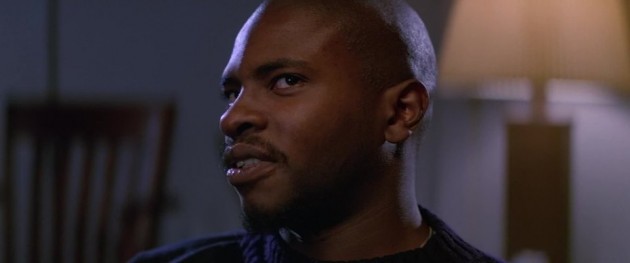
(48) The routine continues with another medium shot of MacReady as he puts the dish down and reheats the wire. He announces that Palmer is up next and (49) we cut to a close-up of Palmer, starring off into space. (50) “This is pure nonsense! Doesn’t prove a thing!” Garry interrupts in his own close-up. (51) “I thought you’d feel that way, Garry.” MacReady replies in a reverse shot, Palmer’s dish in hand. (52) He continues speaking as we cut back to Garry. MacReady explains that Garry was the only one who could have sabotaged the blood samples earlier in the film. (53) “We’ll do you last,” MacReady concludes sternly. He puts the wire in Palmer’s blood and we hear a sharp horrific shriek as the blood violently leaps upwards out of the dish. This sudden burst of movement contrasts with the general stillness of the earlier shots, while the sharp red tone of the blood visually contrasts with the streak of blue lighting on the wall behind it. It is incredibly startling.

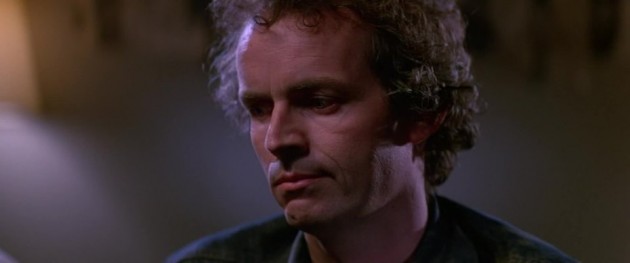
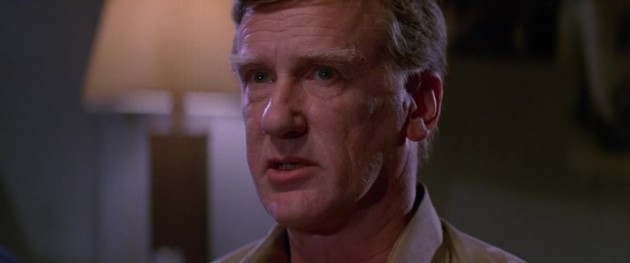
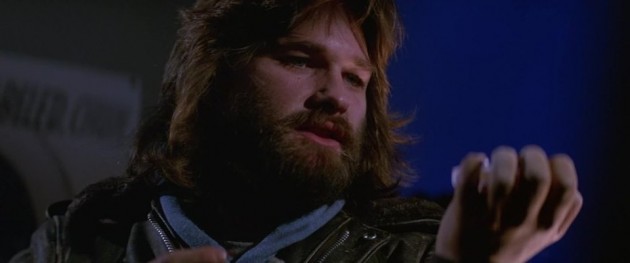
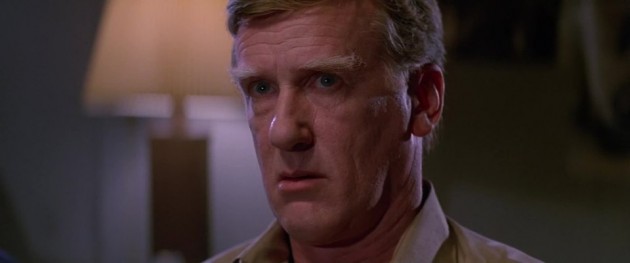
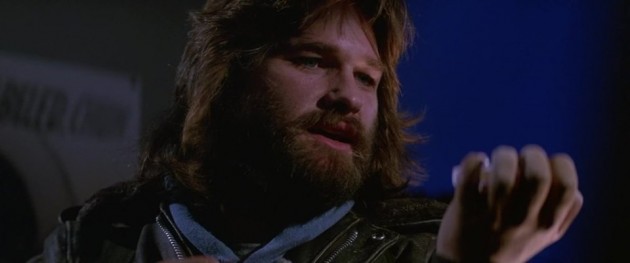
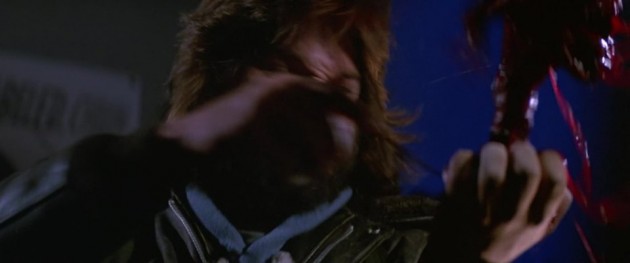
Four shots flash in rapid succession, reinforcing the contrast between the steady earlier shots and the now-hectic situation. (54) A medium shot of MacReady as he drops the dish, stumbling backwards. (55) A close-up of his flamethrower hitting the floor, then getting dragged off frame (56) A wide shot showing all of the characters realizing what has happened – this is the second of the two shots showing all of the characters. (57) The Thing-infected blood moves swiftly across the floor.
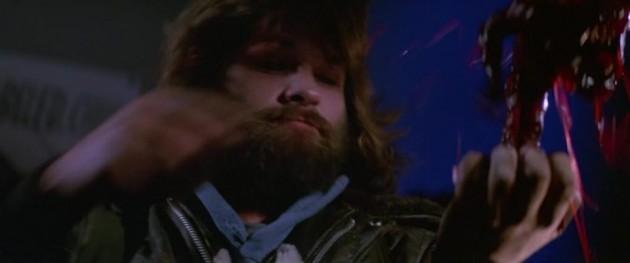
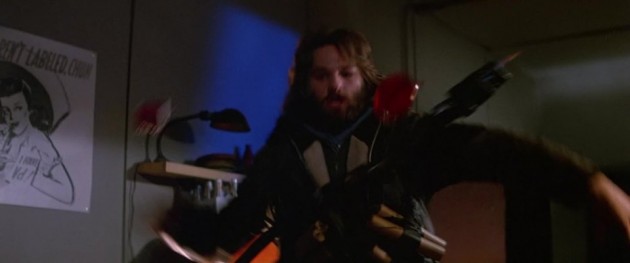
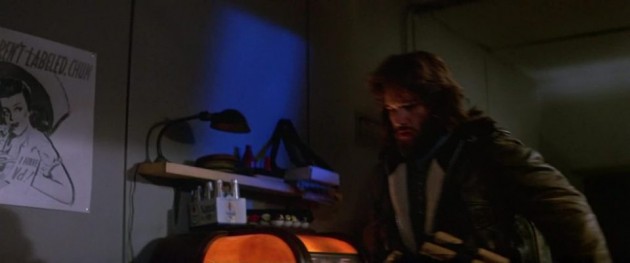

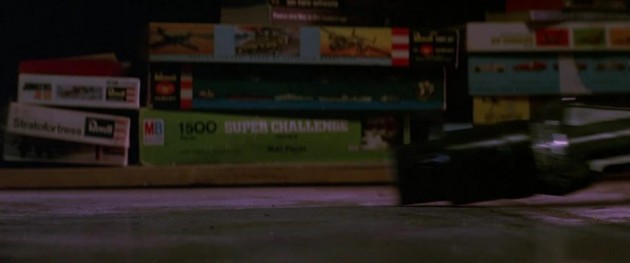
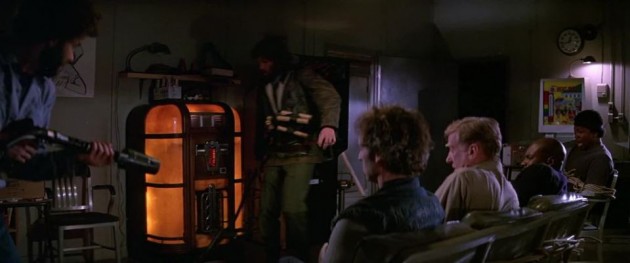
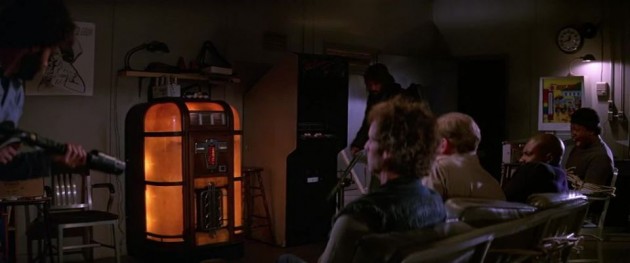
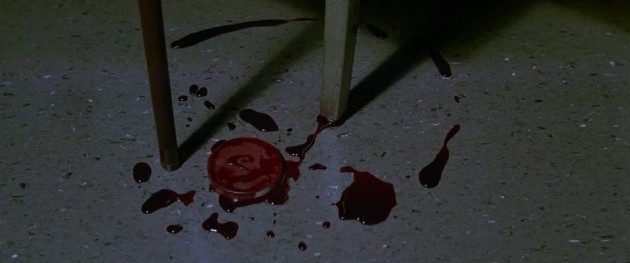
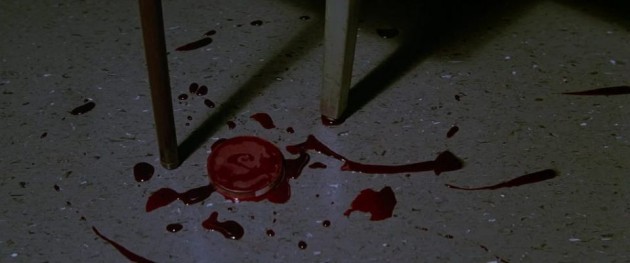
Analysing the first startle, I noted that the small moment where Fuchs knocks a can is meant to misdirect our attention so that the scare will catch us off guard. In this scene, Carpenter essentially turns that short moment into a several-minute-long exercise in audience manipulation. In its sheer length, it can be said to be closer in form to the second startle, which similarly takes its time to build. And indeed, like the second startle, this one also ignores many of the fundamental aspects present in the first. Most notably, this scene lacks music and is totally dependent on editing to guide our attention. Unlike the second startle, however, this startle is fully foreshadowed at the beginning; there is an openly implied threat that does eventually make us jump. While this makes the startle more conventional (at least in terms of Baird’s list of core qualities mentioned in the first half of this analysis), it also makes it interesting to study. By tipping us off, Carpenter is put in a position where he must carefully misdirect us.
It could also be argued that the sheer fact that Carpenter does not introduce an unforeseen element, as he did in the second startle, aids this one’s unpredictability. In other words, some audience members might be expecting something to come out of nowhere instead of waiting for the scare to come from the established threat. On top of this, even if they do expect the blood test to work, it is continually hinted that other characters like Clark, and particularly Garry, will be revealed. 7 As MacReady himself notes the instant before the startle occurs, Garry was the only character who could have sabotaged the crew’s blood samples earlier in the film. 8 Through this narrative setup alone, Carpenter can be seen trying to misdirect us in a variety of ways.
And while the startle itself is remarkably well executed, what truly elevates it is Carpenter’s focus on building tension and misdirection. Given that these are achieved through a variety of methods, I will now provide short analyses of individual aspects of the scene. Specifically, I will discuss the cutting speed, the framing of the characters, the use of eye movements, and the sound. Finally, I will discuss what I feel to be the overall editing style of this scene (and the film in general).
Cutting SpeedFor reference, the following is a list of the shot sequences followed by each sequence’s duration (D), number of shots (NS), and average shot length (ASL). (Both the duration and average shot length are measured in seconds.)
Shots 1-6: Explaining the Test ———————————————- D: 75 – NS: 6 – ASL: 12.5
Shots 7-15: Collecting the Blood ——————————————— D: 50 – NS: 9 – ASL: 5.5
Shots 16-22: Faith in the Test ———————————————— D: 26 – NS: 7 – ASL: 3.7
Shots 23-30: Windows ————————————————————- D: 14 – NS: 8 – ASL: 1.8
Shots 31-37: MacReady ———————————————————— D: 30 – NS: 7 – ASL: 4.2
Shots 38-47: The ‘Doc’ & Clark ——————————————— D: 36 – NS: 10 – ASL: 3.6
Shots 48-53: Palmer (The Startle) ——————————————- D: 20 – NS: 6 ASL: 3.3
Shots 54-58: Drawing it Out —————————————————- D: 6 – NS: 4 – ASL: 1.5
Rather than use music, it could be said that Carpenter uses the rhythm of the cuts to manipulate our emotions on a more subtle level. Here I would like to explain how I think the film uses the length of the shots to do this.
From the list provided, it can be seen that the sequence starts relatively calmly. As the testing commences, the cutting gets faster until it eventually reaches a “peak” when Windows is tested. For these shots, the growing rapidity of the editing helps create an expectation that something is going to happen when the wire touches the blood. When the blood merely fizzles, the editing speed again becomes calm. The change is not enough to be noticeable while watching the film, but it is enough to remove some of the tension from the testing.
At this point, the cutting speed becomes a little devious. The shots once again gradually speed up, yet it is not because of the test. Rather, the editing gets faster because the characters start openly voicing skepticism over whether the test will prove anything. In fact, the moment in which the editing accelerates again is the one in which Childs expresses his disbelief in the test and begins criticizing MacReady. Much as we stop seeing the test’s strong visual motifs, the film starts ignoring the rhythm of the testing as well, opting instead to follow the growing drama between the characters. Naturally, once this drama reaches its own peak (MacReady arguing with Garry), the startle strikes, catching us off guard.
This can almost be seen as Carpenter undermining V.I. Pudovkin’s concept of the ideal “imaginary observer,” in which each shot “concentrates the attention of the spectator only on that element important to the action” (85). At first, Carpenter guides our attention through the blood testing in an appropriately dramatic way. However, when the testing becomes tiresome, it seems natural to gradually ignore this element and instead focus on something more interesting. Once the startle occurs, however, we can see that the editing has actually led us completely astray.
Character Framing and the Anamorphic Close-UpAnother thing that fascinates me about this scene is the prominence of the close-up. To quote Fritz Lang on his experiences with ultra-widescreen film formats: “When you have two people you can fill [the frame] up with walking around, taking something someplace, so on. But when you have only one person, there’s a big head and right and left you have nothing” (Bogdanovich 224). Here Lang articulates a problem several Classical Hollywood directors had with the ultra-wide film formats that emerged in the 1950s. As Sheldon Hall writes, even for directors who accepted these formats, “the close-up became much rarer,” as “the medium-to-long shot, often coupled with the long take, with action staged in breadth and depth, came to predominate” (68). Looking over the shots provided for the previous scenes of The Thing, it can be seen that the film follows the latter tendency fairly closely. 9 However, if we look at the images of the blood test scene, what becomes interesting is Carpenter’s decision to ignore this tradition and instead construct a scene around intense close-ups. This is particularly striking given the characters in the scene are actually positioned in close proximity to each other and could have easily been filmed together.
And yet the close-ups work beautifully for setting the thematic tone of the scene. On a basic level, the close-ups help increase the intensity of the scene. At the same time, as I briefly mentioned when analyzing the second startle, they also reinforce the sense of mental isolation. What the ultra-wide anamorphic frame contributes is exactly what Lang complains about: vast areas of “nothing” on either side of the characters. In this film’s case, these areas serve greatly to illustrate the sheer extent to which they have become disconnected from each other, despite being physically close.
Moreover, when the film actually has characters sharing space, usually there is a reason for it. For instance, MacReady implicitly trusts Windows more than the others (likely because Windows was the only still-living character who didn’t gang up on him earlier). This trust isn’t only implied through MacReady choosing Windows as his assistant for the blood testing, but also by having the two occasionally framed together in a manner which doesn’t graphically stress a disconnection.
A Dance of EyesWith this heavy use of close-ups, eye movements – even subtle ones – become extremely important. Given this, Walter Murch’s notion that editing can be seen as a “dance of eyes” is helpful in reading how Carpenter suggests things to us through these movements (“The Cutting Edge”).
Early in the scene, the shots of characters looking at the blood and metal wire, often accompanied by close-up POV shots, seem to communicate the validity of the test in their minds. When characters start looking at each other as opposed to these objects, we start to sense skepticism. These gazes weave most of the scene together and, as mentioned earlier, they help guide our own views on the test’s efficacy.
However, there is a more pragmatic reason for watching their eyes. Given that their eyes reveal what characters may be thinking, what they look at, and when, may reveal who is infected. Amusingly, as the scene progresses, it momentarily does. The only time the “dance” is broken comes after MacReady announces that Palmer’s blood is about to be tested. Rather than look at the test, Palmer simply stares off into space. It is the only time in which, for the entire duration of a shot, a character doesn’t look at anything; as if he already knows what will happen and no longer needs to watch. We may not think about this when viewing the scene though, given that right after this shot we cut to Garry voicing his complaints.
SoundOne aspect I have not dealt much with yet is the use of sound. I mentioned the lack of music, however it is also noteworthy that much of the scene plays over little more than the sound of the cold wind blowing outside their small outpost. It is an incredibly faint sound that subtly reminds us of their physical isolation from the rest of humanity, as well as the hostility of the surrounding environment.
With respect to the startle, the near-silence works to great effect when the film wants us to be prepared for a shock early in the testing. As the wire descends into the Windows’ dish, we expect a loud noise to erupt. However, as the first test is performed, we get only the minor squeak of the metal wire scratching against the dish and the fizzing sound of burning blood. As the tests continue, the characters slowly begin talking to each other, filling the silences with their bickering. Once again Carpenter plays on our expectations. Seeing as most startles work by having a drawn out silence filled with a sudden loud noise, by slowly filling the scene with the noise of the characters talking, Carpenter further adds to our doubt that the blood will do anything. Then, in a calculated move, during a short pause in the dialogue, he strategically inserts the ear-piercing shriek of the alien blood.
For further reference, I have included a useful generated waveform in an “Extra Shots” section of the Shot Guide under the number 1. It clearly shows how, after the first test, the “silences” become markedly shorter. It also demonstrates just how much louder the startle is in comparison to all the other noises.
General StyleAlthough I have gone through great effort to explain the many effectively used formal qualities of this scene, I would emphasize again that this scene would like most of its form to remain invisible. Carpenter strives to be a storyteller in the Classical Hollywood vein. In a 1978 article with Sight and Sound, he is quoted as saying that if he could have three wishes, he would have one send him back to the 1940s (Milne and Combs 95). Carpenter has also expressed a deep admiration for Howard Hawks in particular and, as Hall writes, comparisons are often made between Hawks’ “stylistic self-effacement” and Carpenter’s own stylistic tendencies (69). Therefore, with respect to editing, it would be appropriate to say that The Thing conforms to Noël Burch’s concept of the “zero point of cinematic style” (15). That is to say that Carpenter does not want the editing (or other parts of the form) to distract from the story he is telling. Space and time are often respected, and the few instances in which he bends them tend to be so quick that they are not readily noticeable, as when we see Windows hold his breath between shots.
And yet, as Hall notes, Carpenter has a counter-influence: the openly manipulative and noticeably stylized work of Alfred Hitchcock (70). Carpenter may not want his style to be as apparent as Hitchcock’s; however, watching the blood testing scene, he does try to be as thoroughly cunning and calculating. It could almost be said that Carpenter tried to resolve these two conflicting approaches in The Thing, effectively making a film that was as manipulative as possible, yet which simultaneously appeared as though it was merely presenting information in a straightforward, objective manner.
In other words, perhaps the monster may be seen not simply as an allegory for several sociopolitical issues of the early 1980s, but as a reflection of this approach to filmmaking. 10 Simply put, underneath the apparently familiar, benign surface, there lies a covert, determined and duplicitous consciousness. Or, to shamelessly warp a quote from Carpenter’s later film Prince of Darkness (1987): while order does exist in this universe, it is not at all what we had in mind.
ConclusionLooking back, I may have drawn this out a little too far. And indeed, it is impossible to tell whether every aspect mentioned was intended by John Carpenter. Still, even if several of the qualities were n0t consciously intended, so much of this scene works towards building tension and misdirection that I do think it shows an incredibly fine intuition on his part.
That said, I don’t want to single him out as the only creative force on this film. Editor Todd Ramsay and cinematographer Dean Cundey also helped greatly in creating the mood and pacing of the scene. There is also the effects work by Rob Bottin, which allowed for such a beautifully surprising startle in the first place. And finally, I would be remiss if I did not mention the performances, particularly those of Kurt Russell, Keith David, and Donald Moffat, who propel the drama needed for the misdirection.
Frankly, at this point, I think the greatest praise I can give the scene is that, in spite of this analysis, it still works on me. It is so carefully constructed that I cannot help but get caught up in it every time I see the film. It is like watching a magic trick you have seen a hundred times before performed by a brilliant magician; you may know the motions but, performed with precision and confidence, you will end up startled once again.
Extra Shots
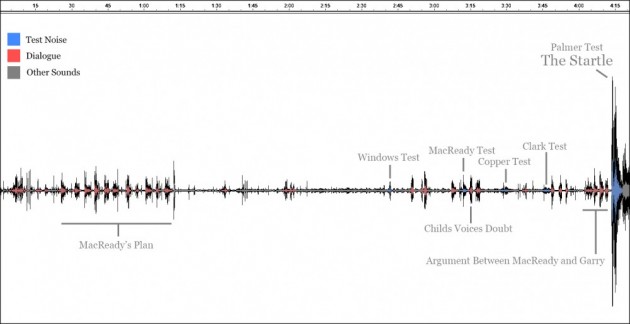
Waveform
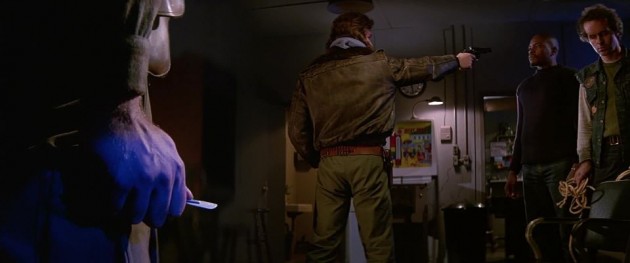
Sharp Blue Light
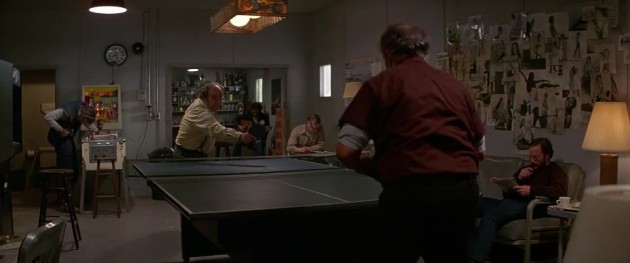
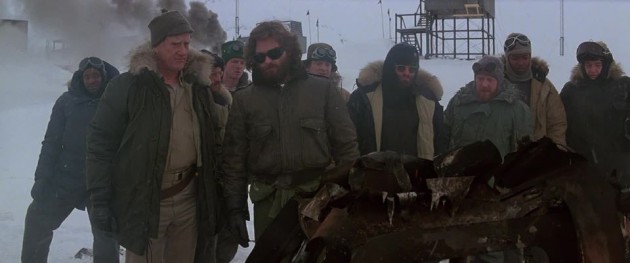
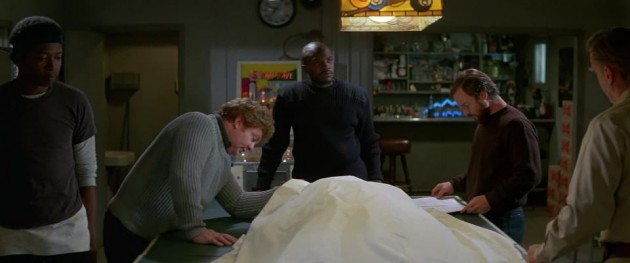

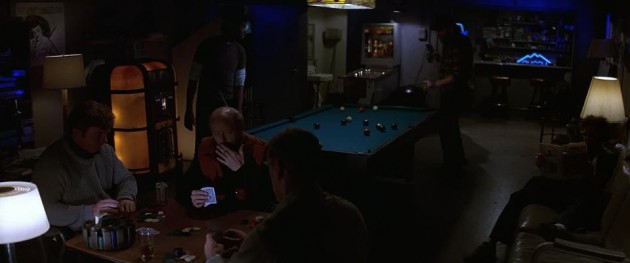
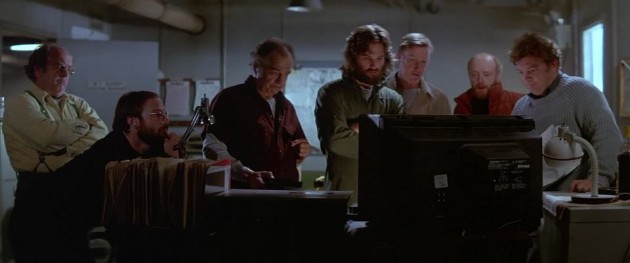
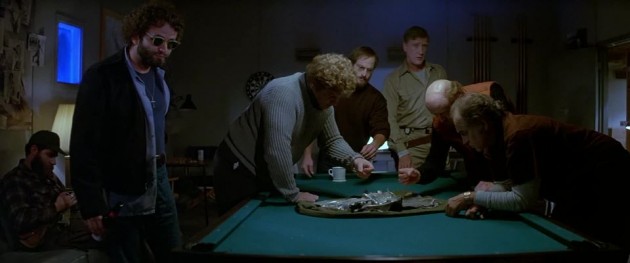
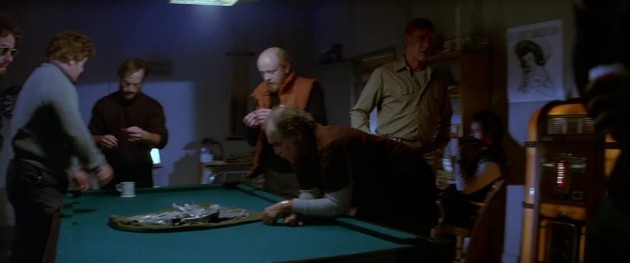
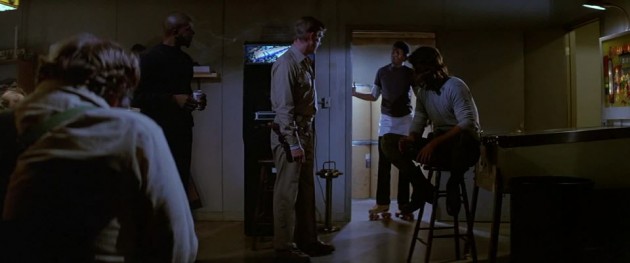
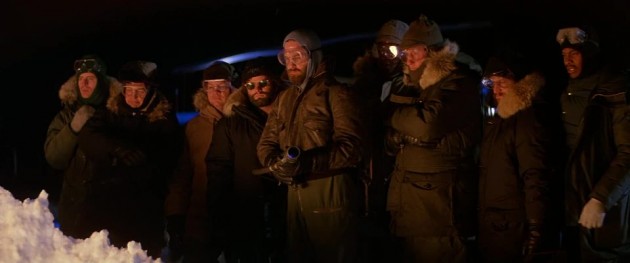
Bibliography
Bogdanovich, Peter. Who the Devil Made It. New York: Alfred A. Knopf, 1997. Print.
Burch, Noël. Theory of Film Practice. New York: Praeger, 1973. Print.
Carpenter, John and Kurt Russell. “Audio Commentary.” The Thing. Dir. John Carpenter. Perf. Kurt Russell, Wilford Brimley, and Keith David. 1982. Universal Pictures, 2004. DVD.
Casper, Drew. “Audio Commentary.” 12 Angry Men. Dir. Sidney Lumet. Perf. Henry Fonda. 1957. 20th Century Fox, 2008. DVD.
Conolly, Jez. The Thing. New York: Columbia UP, 2014. Print.
Hall, Sheldon. “Carpenter’s Widescreen Style.” The Cinema of John Carpenter: The Technique of Terror. Ed. Ian Conrich and David Woods. London: Wallflower, 2004. 66-77. Print.
Milne, Tom, and Richard Combs. “The Man in the Cryogenic Freezer.” Sight and Sound Spring 1978: 94-98. Print.
Pudovkin, Vsevolod. “On Editing.” Film Theory and Criticism: Introductory Readings. Ed. Gerald Mast and Marshall Cohen. New York: Oxford UP, 1985. 83-89. Print.
The Cutting Edge: The Magic of Movie Editing. Dir. Wendy Apple. 2004. Warner Bros. Home Video. 2005. DVD.
Notes
- It is worth noting that the idea for this scene originates from John W. Campbell’s Who Goes There? (1938), the novella upon which the film was based. Nevertheless, the way it unfolds in this film is markedly different from how it is presented in the original story. Notably, in the film, only one character is shown to be the Thing, whereas a great many are revealed to be infected in Campbell’s story. ↩
- This lighting seems to reference the shot immediately before Clark lunges at MacReady. It is similar in composition to the earlier split-diopter shots of Clark holding the scalpel (Shots 14 and 17 from Example 2 from Part 1). However, unlike that earlier shot, in this case Clark’s hand is lit with a sharp blue light, suggesting possible infection. For comparison, you can see it under the number 2 in an “Extra Shots” section of the Shot Guide. ↩
- I am unsure if this has been psychologically proven or if it just an accepted notion among Western directors and cinematographers. Whatever the case, as Jez Conolly argues in his book-length study of The Thing, the film tends to reflect many of the established ideas about how viewers read images. Specifically, although he doesn’t look at camera movement, Conolly claims that Carpenter is greatly influenced by earlier directors – Hitchcock is mentioned – in his identification of the right half of the screen with “strength” and the left half with “weakness” (54-6). As his main focus, Conolly notes how characters are often framed on the right side of the screen when they are supposed to look powerful, while they are framed in the opposite manner whenever they are meant to look vulnerable or uncertain (56-8). What this shows is that, whether these techniques work or not, at the very least Carpenter seems to believe in them. ↩
- This does not include Blair, who was forcefully imprisoned in a cabin and isolated from the group after he attacked them and sabotaged the radio equipment in an effort to prevent the Thing from escaping. ↩
- This is not simply because he tried to kill MacReady. At an earlier point in the film the audience is informed that there was an opportunity for the Thing to infect him when it first got to the camp disguised as a dog. ↩
- Carpenter does actually add one new element: the prop hand with the special effect rigged in it. Naturally, this addition is meant to go totally unnoticed and, according to Carpenter, he put it in a few shots early for the express purpose of making us less likely to notice it later (Carpenter and Russell). ↩
- It is not insignificant to point out that, in the novella itself, one of the big reveals during the blood test scene was that Garry was among the people infected by the Thing. Those who had read the original story might suspect him for this extra-textual reason. ↩
- When watching the film for the first time, it looks as though this is the case. Watching it again with an attention to detail, this apparent plot hole is explained. In one scene, Copper (who also had access to the keys) lent them to Windows. When Windows stumbles across the Thing assimilating Bennings, we can hear them drop to the floor. It can thus be assumed that whoever else was infected at that time could have picked them up and gotten to the blood. Windows likely didn’t reveal this out of fear of being suspected. ↩
- It could be argued that, with the rise of home video, even films shot as wide as 2.35:1 tended to feature more close-ups to look better when cropped and shown on television. That said, while there are indeed some close-ups earlier in the film, for the most part Carpenter was still heavily concerned with composing for the wide frame, often placing as many characters as possible in any given shot. To better illustrate this point, I included some shots from earlier in the film in the “Extra Shots” section of the Shot Guide. They are under the numbers from 3-10, and these shots illustrate how the characters tended to be framed together prior to the overwhelming paranoia and growing mistrust. ↩
- In analyses I have read, the film is presented as being about, among other things, cold war paranoia, the growing awareness of AIDS, a repressed male fear of homosexuality, a repressed male fear of female sexuality, or just a repressed male fear of sexuality in general. ↩


